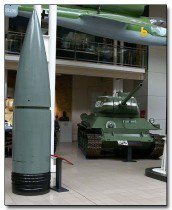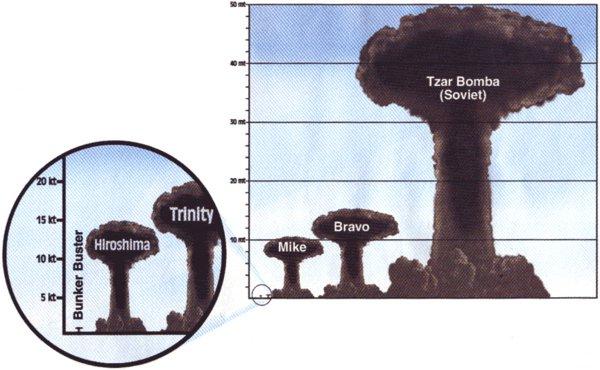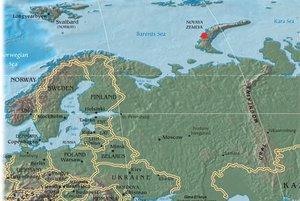The Greatest in the History of War
Wars are naturally the highest points that human stupidity can reach. It is also interesting that human beings, who divide themselves into nations, religions, ideologies or absurd borders and spend 1 trillion dollars every year on armament, are happy with this situation. Knowing that all the problems in the world will be solved in a short time with this much money makes people think even more. The really bad thing is that those who defend this system the most are the ones who suffer the most from it.
In this article, I want to examine a few of the greatest in the history of war, I hope you enjoy reading it. What pleasure does he have, though?
1) The Greatest Weapon: The Schwerer Gustav

Gustav was the greatest weapon ever used in the history of warfare.
"Schwerer Gustav", as it was known in German, was 45 meters long and weighed 1250 tons. If you're having trouble understanding the size of this beast, take a look at the picture below:

The tank standing right behind the bullet is not a toy :) Each of the bullets Gustav used was approximately 3 meters long and 90 centimeters wide. They weighed 6.5 tons and Gustav could throw them 40 km away. Half an hour was required to load the shells.
If you're wondering why the war didn't end the moment they introduced this device to the stage, you need to know how useless this thing is. It took 250 men to assemble it and get it ready to fire, and then another 2,500 to lay the twin rails that would carry it to Russia, the only country in the world big enough to use it.
The Germans considered mounting Gustav's 800 mm gun on a tank and named it Landkreuzer P. 1500 Monster, but unfortunately it never got past the tank design stage.

2) The Greatest Land Battle: Kursk

The Battle of Kursk was the Blitzkrieg attack launched by Nazi Germany against the USSR in 1943.
When the Stalingrad adventure that started in the summer offensive of 1942 turned into a disaster for the Wehrmacht, the Germans began to retreat everywhere on the Eastern Front, and this retreat ended with the recapture of Kharkov by the Germans. A bulge formed in the front line, and Hitler planned to surround and destroy the Red Army units in this region in the 1943 Summer Offensive.
So how seriously were the Germans and Russians taking the war? Look at the attacking side's numbers:
800,000 soldiers, nearly 3000 tanks, more than 2000 aircraft, more than 10,000 guns, mortars, and other weapons.
This was the largest offensive force assembled for a single war in human history. So how could another power stop this power?
Nearly 2,000,000 soldiers, more than 5,000 tanks, nearly 5,000 aircraft, 25,000 cannons, mortars and other weapons.
This was the largest defensive force ever assembled for a single war in human history. Hitler kept postponing the operation to a later date to allow for the increase in the number of newly arrived Panther and Tiger tanks, and thus the Russians turned the Kursk Salient into the best-defended area on earth. The Soviet defensive line was more than 250 km long and 90 km deep. They dug a total of 5,000 km of trenches and laid more than 1 million mines.
When the operation began on July 5, the two armies came face to face in the largest pitched battle in history. On July 17, when the Germans said "enough is enough", nearly 7,000 tanks were burning on the battlefield. Almost 5000 planes were wrecked in smoke.
And more than 1,000,000 soldiers lay lifeless.
If we look at it from another perspective, this number is more than the total number of soldiers who died in all the wars of the Turkish nation so far.
So who won the war? In fact, Germany was heading towards winning the war; But while Hitler was close to winning, he analyzed the situation very badly and canceled the attack. After all, the USSR suffered many, many more losses. But the USSR had enough spare power to replace its dead soldiers and the industry to re-produce the weapons they lost. However, German industry was constantly bombed by the Allies and they had no raw materials. At the end of the Battle of Kursk, the USSR took the initiative completely and the Germans began to retreat continuously until Berlin.

CasualtiesGermanyUSSRSoldier170,000860,000Tank and mobile gun7206064Aeroplane6814209
3) The Largest Nuclear Bomb: Tsar Bomb
The Tsar Bomb (Ivan the Great) was a 57-megaton thermonuclear bomb detonated by the USSR on the island of Novaya Zemlya on November 30, 1961.
57 megatons is equal to the energy of exactly 57 million tons of TNT and is 4000 times more than the 14,000 tons of atomic bomb dropped on Hiroshima and 10 times more than all the bombs detonated in World War II combined. To understand the power of the bomb, take a look at the image below, which compares the size of the atomic bomb dropped on Hiroshima with the Tsar Bomba:

The TU-95 type aircraft, piloted by Captain Andrei Durnovtsev, released the bomb at approximately 10,500 meters, and the bomb, whose parachute was opened, descended to 4000 meters in 188 seconds. Meanwhile, the plane was 76 km away from the bomb and was safe. The effects of the bomb were incredible when sensors detecting air pressure detonated the bomb at the required height at 11.32 am.

The fireball that emerged with the explosion of the bomb reached 10,000 meters downwards and upwards. The temperature inside rose to millions of degrees, and everything within a 45-kilometer radius - stones, rocks, trees, houses, buildings - evaporated. The pressure at this point hit 300 PSI. The fireball was so bright that it could be seen from 1000 km away and could cause 3rd degree burns from 100 km away. Even in Norway and Finland, windows were broken and entire buildings up to 55 km away were destroyed. The resulting mushroom cloud rose as high as 64 km and was 40 km in diameter. The wind of flame blowing at a speed of 4000 km, which started after the fireball, flattened everything. The shock wave created by the bomb traveled around the world 3 times.

The bomb, weighing 27 tons, 8 meters long and 2 meters wide, was originally designed to be 100 megatons, but in order to reduce nuclear waste, a certain part of the uranium was replaced with lead and the power was reduced to 50 megatons. Thus, the bomb obtained 97% of its power from fusion. However, such a bomb was militarily useless because at that time the only way to deliver nuclear weapons to the target was by planes, and it was almost impossible for any plane to deliver such a large bomb to its target thousands of kilometers away without being hit. The aim was to demonstrate political power. In the picture below, you can see the effect the bomb would have if dropped on Istanbul:

4) The Greatest General: Subutay
If the criterion was to win the most wars and conquer the most lands, Subutay was the greatest general who ever lived in history.
At the age of 17, from a poor family, he joined the army of the Mongol Emperor Genghis Khan and turned out to be good, very very good. By the end of his career, he had conquered 32 countries, won 65 major battles, and captured more territory than any commander in history. He was the only man to successfully capture Russia.

Equipped with Chinese technology, a widespread spy network, and the most effective war machine known to man until World War II, Subutai (1176–1248) conquered China and Persia before turning west. After Genghis Khan died, Ögeday Khan, who succeeded him, ordered him to advance west until he reached the Atlantic Ocean. Subutay's cavalry headed 450 km into Europe in the middle of winter, in ice and snow, within 3 days, and the Mongols' spy network extended to England.
The most important feature of Subutay was that he won the victory with the most creative and sophisticated strategies and by coordinating armies hundreds of kilometers away from each other. He also placed great emphasis on siege weapons and engineers. He had made it an art to obtain information from his spies and act accordingly.
In 1241, Subutai completely destroyed the armies of Hungary and Poland in two separate battles, fought 320 km away from each other, one day apart. He implemented such a strategy in his war with the Hungarians that he lost only 1,000 soldiers compared to 40,000 enemy soldiers.
And he did it all as the guy pictured below:

5) The Greatest Naval Battle: Poyang

Ironically, the god of war, in order to maintain balance, deemed it appropriate to hold the largest naval battle on a lake. The Battle of Poyang Lake is the largest naval battle (or water war?) in history.
As we know, when we think of China, two things come to our mind:
1) They invented everything: paper, the compass, gunpowder, the printing press, acupuncture, banknotes, beer, toothbrushes, solar calendars, dominoes, fireworks, kites, naval mines, playing cards, porcelain, fans, seismographs, tea, toilet paper, wheelbarrow, parachute, ship steering wheel, washing machine, dishwasher, television, internet, sex, homosexuality, heterosexuality, bisexuality, automobile, submarine, speedboat, airplane, glider, jet engine, Wheel of Fortune, Aşk-ı Memnu, Valley of the Wolves, AIDS, SARS, Chinese flu, bicycles, motorcycles, vaccines, rearview mirrors, seat belt warning silencers...
You name something and they invent it before anyone else!
and 2) They have the highest population in the world! This being the case, it would be surprising if China's name was not mentioned among the biggest ones. The largest naval battle in history was fought on China's largest freshwater lake, and a total of 850,000 sailors fought in the conflict between the Han dynasty and the Ming dynasty. This number is 17 times the size of today's Turkish navy and 2.5 times the size of the American navy. And this battle was fought in 1363!

According to what is said, the Han navy encountered the Ming navy at Poyang Lake. The Khan's navy was by far the largest, numbering 600,000 sailors with 11 fleets. The navy was equipped with literally floating fortresses called Lou Chuan.
Although Poyang is China's largest lake, its water level had decreased considerably due to the summer months, and the two navies were actually fighting their biggest naval battle in a giant water tub.
The strategy for victory was suitable for such a frantic war. The Ming built a bunch of fireships, kamikazes filled with explosives and the most flammable materials they could find. They put scarecrows made of straw and decorated with human ornaments on these ships and sent them against the enemy. The flames engulfed the Khan's ships and hundreds of thousands of sailors were burned alive.

By the end of the war, the Ming's small navy had won, and the corpses of hundreds of thousands of sailors were afloat. To this day, with regular reports of ships disappearing without a trace, Lake Poyang became known as China's Bermuda Triangle and still is. Who knows? Maybe it has something to do with a lot of angry ghost sailors.
Source:
https://dergipark.org.tr/



































